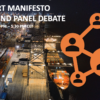We had an interview with Erwin Verstraelen, Chief Digital & Innovation officer at Port of Antwerp. He explains the company’s approach to upgrade and involve port stakeholders to contribute to a Smart Port Ecosystem.
The Port of Antwerp and its Port Information and Control System (APICS) was one of the first initiatives that were taken in Europe in the early 80’s to centrally share data amongst port users. The APICS functionalities are derived from the need of a detailed lock planning. These functionalities were expanded incrementally by gathering data necessary for the dock planning and setting in practice a focus to serve, with data, as much as possible stakeholders (for example the tugboats, the pilots etc., but also terminal operators and shipping lines). In the meantime, APICS and NxtPort initiatives have made it possible for Port of Antwerp users not only to benefit from a lock planning tool, but also to enjoy both high-end port planning and data exchange tools. Currently, as a result of having the right mindset and applying a consistent long-term vision, various services and activities can be ordered and planned through the platforms present at the Port of Antwerp and their extensions. The following paragraph details how the functioning of a Smart Port Ecosystem can be visualized.
“The vision of developing a digital nervous system for the port is starting to take shape.”
Erwin Verstraeten, Chief Digital & Innovation Officer at Port of Antwerp
How can one visualize the functioning of a Smart Port Ecosystem?
A smart port is a port that knows at every moment what it is doing and how it is doing it. Digital solutions cover the physical layer and continuously sense what is happening in the port from different perspectives: operational, safety, security, environmental etc. It is not possible for a human mind to comprehend this type of monitoring, but a well-designed model could provide the expected results. To achieve this type of monitoring, data would need to be integrated from water and air sensors, LORA network, sensor buoys, bollards that measure the stress on ropes, cameras, 3rd party systems etc. Sometimes, it is a pity that technologies available in the port are not known by the general public, yet in terms of digitization, the functioning of a Smart Port Ecosystem can be compared to the nervous system of the human body. The vision of developing a digital nervous system for the port is starting to take shape.
Which concrete initiatives show how a Smart Port is being built?
Recent developments have been set in place to stimulate data sharing in port operations and make use of digital technologies. The Port of Antwerp is the home of the following innovative initiative in port operations:
- In terminal operations and container handling: operational gains are obtained by means of predicting what the next mode of transport is of each container. Historical data is used to optimize container movements within the terminals.
- In tracking of refer containers: a new initiative makes use of the LORA network inside the port to visualize where refer containers are.
- Rail operations monitoring: an ambitious plan to monitor the trains moving through the port, which can be done by integrating the train operators’ data and offer more transparency to the freight operators that might be interested in making use of rail transport.
- Developing a transcontinental integrated cybersecurity trade lane: this secure trade lane is designed for the Belgium to Canada axis. Initial steps are taken to bring all the interested parties in this trade lane around the table, map out existing building blocks and define gaps that should be addressed.
- In the breakbulk cargo flow: digitalization is kicked at speed in the breakbulk industry that benefits from new functionalities in terms of data sharing from the app Bulkchain. Read here what Bulkchain is.
- Collaborative dock planning: dock planning data is centralized and integrated so that the terminals and ships owners can have extended benefits. This is an initiative that all 15 terminals showed interest in and now a pilot project is running with three terminals.
The experience of developing new initiatives shows that there is no straight line to develop Smart Port Ecosystem initiatives.
What are barriers for developing a Smart Port Ecosystem?
One of the obstructions for building a smart port ecosystem is the focus of organizations involved in the supply chain on their own P&L (profit and loss). These stakeholders want to capitalize too much on their own ERP data, while the focus should be on benefits that can be achieved through collaboration. Moreover, this focus is sometimes not even centralized within global organizations and corporations. The communication relation with corporate headquarters of global companies is thus very important here. One has to make sure that innovation at a local level is approved. There is always the issue of getting many stakeholders to move in the same direction. Supply chain is still in its early phase of getting into this phase of collaboration. The mindset of reinventing the wheel all the time has to change, and the use of what is already there and extend based on that should prime.
“Ports still face two main barriers in building Smart Ports Ecosystems as some stakeholders lack of a proper data sharing mindset and vision”
Erwin Verstraeten, Chief Digital & Innovation Officer at Port of Antwerp
Port stakeholders should leverage on the contemporary context to start developing a Smart Port Ecosystem.
What are contemporary drivers for building a Smart Port Ecosystem?
There are still many benefits that can be achieved as low hanging fruits, in the area of port operations optimization. Currently, the following elements might stimulate the development of Smart Port Ecosystems:
- the Covid-19 situation
- the need to cut costs for building new platforms
- the environmental pressure
- the local level obligations such as Certified pick-up of containers
- the federal and European enforcement of digitalization of documents
- last but not least, the technological readiness
Moreover, there was a long way to build, but more and more port stakeholders start to have the right mindset about certain decisions regarding data sharing. This mindshift would bring benefits that are enjoyed together with the community.
“Rather than talking only about costs, let’s talk openly about benefits like increased performance and collective competitive advantage”
Erwin Verstraelen, Chief Digital & Innovation Officer at Port of Antwerp
The role of the port is central in community and ecosystem building. Community building actions should be set to bring stakeholders together and define the milestones for a common vision. It is maybe a trick to not only talk about costs in the first place, but to make everyone aware of the gains that they can have (such as operational efficiency). The idea of selling data to the stakeholders that you also depend on, does not make sense, according to Erwin Verstraelen. This track reaches a dead-end fast. The primary goal of port stakeholders should be the operational efficiency inside the port. The achievement of this milestone will bring extra revenue streams from leveraging on data, increasing competitiveness or by valorizing it outside the port.
“The port has a responsibility as node in a chain to strengthen it and it is the holistic approach that is going to make a change.”
Erwin Verstraelen, Chief Digital & Innovation Officer at Port of Antwerp
Port stakeholders willing to contribute to a Smart Port Ecosystem should stop talking about the costs and focus on the benefits of working together as a community.
What is a future Smart Port Ecosystem?
“The discussion about who is the beneficiary of data sharing should not be focused on the stakeholders in the port or in the supply chain, but it should focus on the customers of the chain.”
Erwin Verstraelen, Chief Digital & Innovation Officer at Port of Antwerp
A future Smart Port System will be built by open minds, collaboration and joint forces. Moreover, the stakeholders contributing to it should follow a win-win approach. The discussion about who is the beneficiary of data sharing should not be focused on the stakeholders in the port or in the supply chain, but it should focus on the customers of the chain. The challenges are becoming so big that being the biggest player in a chain, where all the others are struggling, will not last for long. Now is the moment to make use of small data sets, make baby steps and soon we will see that everything together will have a huge impact. In this context, setting a federated model for data governance and examples is key.
Blog article written by Valentin Carlan, Post-doc Researcher at University of Antwerp, Faculty of Applied Economics/ Department of Transport and Regional Economics



